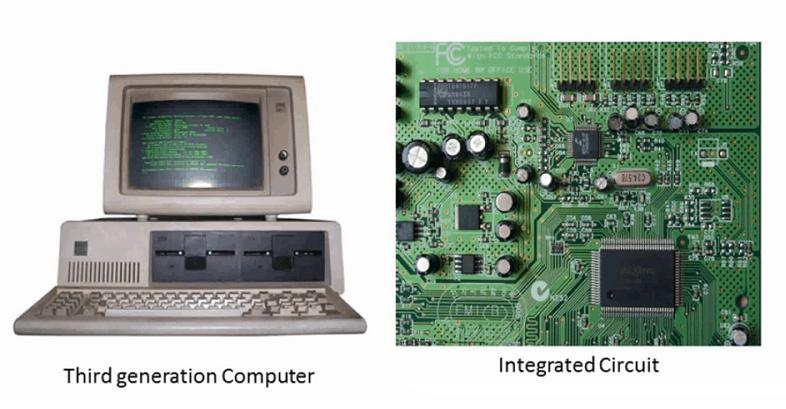Introduction
In1958,theengineerofTexasInstrumentsJackKilbyinventedtheintegratedcircuit(IC),combiningthreeelectroniccomponentsintoasmallsiliconchipsuperior.Morecomponentsareintegratedonasinglesemiconductorchip,andcomputersbecomesmaller,consumelesspower,andarefaster.Thedevelopmentofthisperiodalsoincludedtheuseofanoperatingsystem,whichallowedthecomputertorunmanydifferentprogramssimultaneouslyunderthecontrolandcoordinationofthecentralprogram.
Features
LSI(Large-ScaleIntegration)isusedtoformthemainfunctionalcomponentsofthecomputer,integratedcircuits(integratedhundredstothousandsoflogicgatesoneachchip)Itisalogiccircuitformedbyconcentratingmultipleelectroniccomponentsonasubstrateofafewsquaremillimeters.Thebasicelectroniccomponentsofthethird-generationcomputeraresmall-scaleintegratedcircuitswithseveraltoadozenelectroniccomponents(logicgates)integratedoneachsubstrateandmedium-scaleintegratedcircuitswithdozensofcomponentsoneachchip.
Thefurtherdevelopmentofcomputersoftwaretechnology,especiallythegradualmaturityoftheoperatingsystem,isasignificantfeatureofthethirdgenerationofcomputers.Thedevelopmentofmultiprocessors,virtualmemorysystems,anduser-orientedapplicationsoftwarehavegreatlyenrichedcomputersoftwareresources.Inordertomakefulluseoftheexistingsoftwareandsolvetheproblemofsoftwarecompatibility,aseriesofcomputershaveappeared.ThemostinfluentialistheIBM-360computerseriesdevelopedbyIBM.
Anotherfeatureofthisperiodistheapplicationofsmallcomputers.ThePDP-8,PDP-11seriesandlaterVAX-11seriesdevelopedbyDECCorporationhaveplayedagreatroleinthepromotionofcomputers.Itischaracterizedbytheuseoftransistorsinsteadofelectrontubes;alargenumberofmagneticcoresareusedasinternalmemory,andmagneticdisks,tapes,etc.areusedasexternalmemory;thesizeisreduced,thepowerconsumptionisreduced,thecalculationspeedisincreasedtohundredsofthousandsofbasiccalculationspersecond,andthememorycapacityisexpandedtoHundredsofthousandsofwords.
Whenthecomputerlanguagedevelopstothethirdgeneration,ithasenteredthe"human-oriented"languagestage.Thethird-generationlanguageisalsocalled"high-levellanguage".High-levellanguageisaprogramminglanguagethatisclosetopeople'shabits.ItallowstowritecalculationprogramsforsolvingproblemsinEnglish.Thearithmeticsymbolsandexpressionsusedintheprogramaresimilartothemathematicalformulasweusedaily.Thehigh-levellanguageiseasytolearnandhasstrongversatility.Thewrittenprogramisrelativelyshort,whichisconvenientforpromotionandcommunication.Itisanidealprogramminglanguage.High-levellanguagesdevelopedfromthemid-1950stothe1970s.Somepopularhigh-levellanguageshavebeenadoptedbymostcomputermanufacturersandaresolidifiedinthecomputer'smemory,suchastheBASIClanguage(nolessthan128differentBASIClanguageshavebeenpopular,ofcourseThebasiccharacteristicsarethesame).InadditiontotheBASIClanguage,therearemorethan250high-levellanguagessuchasFORTRAN(formulatranslation),COBOL(CommonBusinessLanguage),Clanguage,DL/Ilanguage,PASCAClanguage,andADAlanguage.
Tietokoneen historia
Kehitysvaihe | Looginen elementti | Päämuisti | Laskelmien nopeus (sekunti) | > Ohjelmisto | > Sovellus |
Ensimmäinen sukupolvi (1946-1958) | Electronictube td> | Elektroninen sädeputki | Tuhattakymmentätuhatta kertaa | konekieli,assemblykieli | Sotilaallinen tutkimus, tieteellinen tietojenkäsittely |
Toinen sukupolvi (1958-1964) | Transistori | > Ydin | Satatuhatta kertaa | Valvontaohjelma, korkeatasoinen kieli | Tietojenkäsittely,tapahtumankäsittely |
Kolmas sukupolvi (1964-1971) | Pienet keskikokoiset integroidut piirit | Puolijohde | Satatuhattatuhattamiljoonaa kertaa | Käyttöjärjestelmä,muokkausjärjestelmä,sovellusohjelma | Se on kehitetty ja alkanut olla laajassa käytössä td> |
Neljäs sukupolvi (1971 - nykypäivään) | Suuressa mittakaavassa integroitu piiri | Korkeammin integroidut puolijohteet | kymmeniä miljoonia satoja miljoonia pehmeitä kertoja | Täydellinen käyttöjärjestelmä,tietokantajärjestelmä,korkeatasoinen kielenkehitys,sovelluskehitys | Tulkeutua yhteiskunnan kaikille tasoille p> |
Ensimmäinen elektroniikkaputkitietokoneiden sukupolvi (1945-1956):
OnFebruary15,1946,ENIAC(ElectronicNumericalIntegratorandComputer)wasmadepublicinPhiladelphia.ENIACrepresentsamilestoneinthehistoryofcomputerdevelopment.Italsohasparallelcomputingcapabilitiesthroughrewiringprogrammingbetweendifferentparts.ENIACisjointlydevelopedbytheUSgovernmentandtheUniversityofPennsylvania.Ituses18,000tubes,70,000resistors,5millionsolderjoints,consumes160kilowattsofpower,andhasacalculationspeedof5,000operationspersecond.Thefirstgenerationofcomputersischaracterizedbyoperatinginstructionsthatareprogrammedforspecifictasks.Eachmachinehasitsowndifferentmachinelanguage,itsfunctionsarelimited,anditsspeedisslow.Anotherobviousfeatureistheuseofvacuumtubesanddrumstostoredata.
Nämä toisen sukupolven transistoritietokone (1956-1963):
Nämä toisen sukupolven transistoritietokone (2 kuvaa)
In1948,thetransistorTheinventionreplacesthebulkyelectronictube,andthevolumeofelectronicequipmentcontinuestodecrease.In1956,transistorswereusedincomputers,andtransistorsandmagneticcorememoryledtothesecondgenerationofcomputers.Thesecond-generationcomputersaresmallinsize,fast,lowpowerconsumption,andmorestableinperformance.In1960,thereweresomesecond-generationcomputersthatweresuccessfullyusedinbusiness,universities,andgovernmentdepartments.Second-generationcomputersusedtransistorsinsteadoftubes,andsomepartsofmoderncomputers:printers,tapes,disks,memory,operatingsystems,etc.Theprogramsstoredinthecomputermakethecomputeradaptableandcanbeusedmoreeffectivelyforcommercialpurposes.Duringthisperiod,moreadvancedlanguagessuchasCOBOLandFORTRANappearedtomakecomputerprogrammingeasier.Newprofessions(programmers,analystsandcomputersystemsexperts)andtheentiresoftwareindustrywereborn.Thefourth-generationlarge-scaleintegratedcircuitcomputer(1971-):
Neljännen sukupolven suurikokoinen integroitu piiritietokone (3 kuvaa)
(LSI)canholdhundredsofcomponentsononechip.Bythe1980s,verylargescaleintegratedcircuits(VLSI)containedhundredsofthousandsofcomponentsonachip,andlater(ULSI)expandedthenumbertothemillions.Theabilitytoaccommodatesuchanumberofcomponentsonacoin-sizedchipmakesthesizeandpriceofthecomputercontinuetodecline,whilethefunctionalityandreliabilitycontinuetoincrease.Inthemid-1970s,computermanufacturersbegantobringcomputerstoordinaryconsumers.Atthistime,minicomputerswereequippedwithsoftwarepackageswithfriendlyinterfaces,programsfornon-professionals,andthemostpopularwordprocessingandspreadsheetprograms.In1981,IBMintroducedpersonalcomputers(PCs)foruseinhomes,offices,andschools.Thecompetitionofpersonalcomputersinthe1980scausedpricestocontinuetofall,thenumberofmicrocomputerscontinuedtoincrease,andcomputerscontinuedtoshrinkinsize.TheAppleMacintoshseries,whichcompeteswiththeIBMPC,waslaunchedin1984.TheMacintoshprovidesafriendlygraphicalinterfacethatuserscaneasilyoperatewithamouse.Application
1.Numericalcalculation:ballistictrajectory,weatherforecast,highenergyphysics,etc.
2,tiedonhallinta:yritysjohtaminen,materiaalinhallinta,tietokoneistus jne.
p>3. Prosessinohjaus: teollisuusautomaation ohjaus, satelliittien lentosuunnan ohjaus
4. Aputekniikka: tietokoneavusteinen suunnittelu (CAD), tietokoneavusteinen valmistus (CAM), tietokoneavusteinen ohjaus (CAI), tietokoneavusteinen testaus (CAT), tietokoneavusteinen koulutus (CAE), tietokoneavusteinen julkaisu (CAP) jne.

